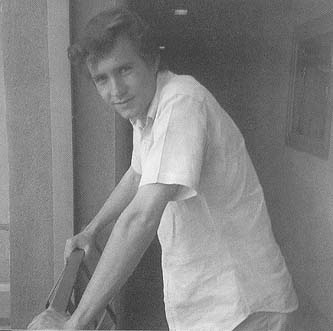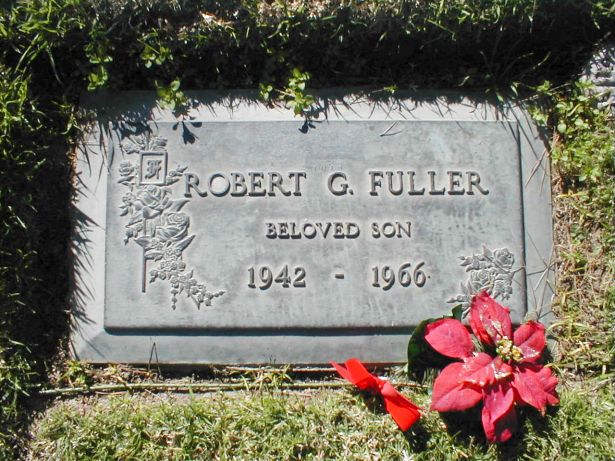Tribute: Bobby Fuller

Bobby Fuller was a charismatic young singer with a huge hit single, "I Fought the Law," and a promising career just beginning to bloom. Ultimately, Fuller's legacy would rest on that one song and on a very bizarre unsolved crime - his murder.
Robert Gaston Fuller was born 22 October 1942 in Texas to Lawson and Loraine Fuller. He joined half-brother Jack Leflar (Loraine's son from a previous marriage), and brother Randy. Jack often ran away from home and was supposedly involved in petty theft and homemade explosives. He eventually maintained limited contact with the family.
Bobby enrolled in college, but soon quit to pursue music. He had been teaching himself to play the guitar. On 22 February 1961, the body of his half-brother, Jack, was discovered; he had been murdered. (No additional information available.) That same year, Bobby gathered some local musicians and recorded "You're In Love" and "Guess We'll Fall In Love." Yucca Records released the two songs as a single in 1961; they performed well. Fuller organized session time at Norman Petty's Studio in Clovis, New Mexico, the same studio used by Fuller's idol, Buddy Holly. Fuller's second single was "Gently My Love" with "My Heart Jumped." Fuller decided to create a studio in his parents' house; he released a third single (covers of Eddie Cochran's "Nervous Breakdwon" and Buddy Holly's "Not Fade Away") on his own label, Eastwood. He opened an all-ages club in El Paso, "Bobby Fuller's Teen Rendezvous," and created Exeter Records, which, in 1964, released three Fuller singles and records by acts such as Los Paisanos and The Sherwoods.
Fuller's second single on Exeter was "I Fought the Law" (with "She's My Girl") written by Sonny Curtis of Buddy Holly's former backing band, The Crickets. "I Fought the Law" would eventually reach #4 on the Billboard charts. Fuller decided a move to California was necessary to capitalize on the single's success and continue the momentum. In November 1964, Bobby Fuller and his band, along with Fuller's mother, Loraine, headed west.

The Bobby Fuller Four were signed to Del-Fi Records and started playing the Los Angeles clubs. The first Del-Fi single was released under the name Bobby Fuller and the Fanatics; the second was credited to The Shindigs (reportedly as an attempt to get a job as the house band for the television show, "Shindig"). Del-Fi producer/owner Bob Keane decided that The Bobby Fuller Four would be the official - and final - name for the group. Keane's direction for the band and the group's own vision were often at odds. It wasn't until 1966 that I Fought the Law, The Bobby Fuller Four's first album, was released. The follow-up single to "I Fought the Law," - "Love's Made A Fool of You" - reached #26 on the charts. It was written and performed by Buddy Holly, but he never got the chance to finish it. (Holly died at the age of 22 in a plane crash, 3 February 1959. Read about Fuller's connection to the Curse of Buddy Holly.)
In 1966 The Bobby Fuller Four embarked on their first national tour. They appeared on Casey Kasem's Teen Dances on 10 July 1966; it would be the band's last performance. Times and styles were changing and Fuller seemed keenly aware of this. He wanted to dissolve The Bobby Fuller Four. "I think all the reporters should go on writing about LSD and its effects, and let the people decide for themselves whether or not they should take it. One thing I know is that you are completely aware of what you're doing, but it's intensified into unreality . . ." Supposedly, Fuller had experimented with the drug at least once. A "friend" said it was at her house that Fuller dropped acid. "About a week before he died, he came over to my place and said he was going to experiment with it, and asked if he could stay the night. I tried to talk him out of it. He'd taken his [LSD] and he had his headphones on - he liked to listen to my stereo with headphones on - and he was trying to write songs, but it didn't work. He kept getting up to go outside and walk around, and I kept goin' out there and bringing him back in."
Meanwhile, the band's guitarist, Jim Reese, was drafted for Viet Nam. He planned on selling his Jaguar to Fuller on Monday, 18 July 1966. A band meeting was also scheduled for that day. But Fuller never arrived for either appointment.

The night of the 17th, Fuller was at his apartment with his mother and the band's roadie. They state that he was still home between midnight and 1 AM, watching television and talking on the phone. Around two in the morning he received a phone call and left, never returning. According to his brother, Randy, "He still had on his lounging clothes," evidence to some that Fuller was not heading out to party or a date. Lloyd Esinger, the manager of Fuller's apartment building, said Fuller stopped by his place about 3 AM, had a few beers, and was in good spirits. It was the last time anyone would confirm seeing Bobby Fuller alive. At 5 PM the next day, his bandmates went to Fuller's apartment to see why he had missed the meeting, but he wasn't there. Fuller's mother later went out to check the mail and spotted the family Oldsmobile in the parking area. She proceeded to the vehicle, opened the driver's side door, and found Fuller dead. "He was lying in the front seat. The keys were in the ignition, and his hand was on the keys, as if he had tried to start the car. I thought he was asleep. I called his name. When I looked closer, I could see he wasn't sleeping . . .he was dead."
View a copy of Bobby Fuller's Death Certificate, from FindADeath.com.
The Los Angeles County Coroner's Office's official autopsy report read: "Deceased was found lying face down in front seat of car--a gas can, 1/3 full, cover open--windows were all rolled up & doors shut, not locked--keys not in ignition." The report also noted excessive bruising on his chest and shoulders, and attributed the cause of death to asphyxiation "due to inhalation of gasoline". Bobby had been drenched in the fuel, saturating his clothes and hair, and his body was found in a full state of rigor mortis (indicating that he had been dead for over three hours). Eyewitnesses testified that Bobby looked battered, as though he had been in a fight, and that "his right index finger was broken, as if it had been bent back." The scene of Fuller's death was never sealed to avoid contamination or tampering and the police never dusted for fingerprints. Witnesses state that a fuel can that was in the vehicle, near Fuller's body, was thrown away by a plain-clothes officer.
Confronted with the above evidence, the Los Angeles Police Department ruled Bobby's death a suicide and the official police report states "there was no evidence of foul play." Family and friends assert that in addition to the circumstances of his death, Fuller was not remotely displaying suicidal behavior. The case was closed and remains sealed under California law. (His death certificate was later amended, so that the cause of death is now listed as "accident.") Bobby Fuller was buried 20 July 1966 in Forest Lawn Cemetery in Burbank.

Conspiracy Theories
Conspiracy theories about Fuller's death abound. Personally, I think its obvious he was murdered and the police either didn't care (for whatever reasons) or were covering it up (for whatever reasons). The gas can mentioned in the coroner's report was said to have been discarded by the police - not tested for prints or kept as evidence, merely thrown out. Judging by the description of Fuller's injuries, he was severely beaten, his fingers were broken, he was soaked in gasoline and drank gasoline. If it was a suicide, there certainly are easier ways to die. When Fuller's uncle went to the police requesting an investigation, he was allegedly told that "if he knew what was good for him, he'd better keep his mouth shut."
Various scenarios suggested by various personalities:
- Fuller went to an "LSD party," freaked out and died in a fall, and then the partiers tried to make it look like suicide.
- Supposedly, four days after Fuller's death, three armed men showed up at the apartment of guitarist Jim Reese and drummer Dalton Powell. Reese thought it had something to do with an insurance policy taken out on him. "I had that insurance policy canceled because I was worth a lot more dead to certain people, and I was taking no chances." Powell commented, "We worked off and on for some real ugly people and I think there were probably some people behind the scenes that just considered us an investment. Maybe they saw it as their $1 million investment about to fly out the window and they wanted to make sure they got something out of it." Randy Fuller said there was a life insurance policy for his brother for between $800,000 and $1 million, payable to an investor in Del-Fi who was suspected of having criminal connections. No such policies have ever been paid out.
- Speaking of criminal connections . . .it has also been posited that Fuller was romantically involved with a (violent and unforgiving) mobster's girlfriend.
- Perhaps exploitation was the motive - Fuller's half-brother, Jack, may have made associations who wanted to capitalize on their knowledge of Fuller's family history. Maybe they desired a continuation of revenge or a payment of a debt.
- Finally, speculation exists that Bob Keane and Del-Fi thought Fuller would be worth more dead than alive, but not in relation to any insurance policies. Ritchie Valens had been on the Del-Fi label; when he perished in the same plane crash that killed Buddy Holly (and J.P. "The Big Bopper" Richardson), his record sales soared. Perhaps someone was trying to create another Rock & Roll martyr.

"I Fought the Law"
"Guess We'll Fall in Love"
"Another Sad and Lonely Night"
"Let Her Dance"
"It's Love, Come What May"
"Phantom Dragster"
"My Heart Jumped"
"Fool of Love"
"Those Memories of You"
"Take My Word"
"Never to Be Forgotten"
"Love's Made a Fool Of You"